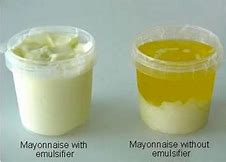The role of emulsifiers enhance shelf life in packaged goods
Emulsifiers: Secret Ingredients for Attaining Flawlessly Mixed Formulations
Emulsifiers play a vital function in developing stable blends of immiscible fluids, such as oil and water. Their special properties allow them to minimize surface area stress, which is crucial for harmony in different formulas. Recognizing the differences between artificial and natural emulsifiers can influence product top quality substantially. As sectors increasingly seek to improve appearance and service life, the option procedure for the right emulsifier ends up being vital. What variables should be thought about in this important option?
Recognizing Emulsifiers: What They Are and How They Function
Although emulsifiers may look like an easy enhancement to solutions, they play a vital function in supporting blends of active ingredients that generally do not mix well, such as oil and water. These compounds work by reducing surface area tension at the interface in between immiscible fluids, enabling them to mix more evenly. Emulsifiers consist of both hydrophilic (water-attracting) and lipophilic (oil-attracting) homes, which enable them to anchor themselves at the limit of both stages. By doing so, they produce a protective obstacle that avoids the droplets of one liquid from integrating right into larger masses, thereby keeping a stable solution. The performance of an emulsifier relies on its molecular structure, which affects its capability to stabilize mixtures. In numerous applications, from food items to cosmetics, emulsifiers assure a consistent appearance and appearance, improving both performance and consumer allure. Their importance can not be overemphasized in attaining well-blended formulas.
Kinds of Emulsifiers: All-natural vs. Artificial
Emulsifiers can be extensively categorized into 2 types: natural and artificial, each offering unique benefits and applications. All-natural emulsifiers, stemmed from plant or animal resources, include gum, casein, and lecithin arabic (emulsifiers). These emulsifiers are commonly favored in clean-label and organic products due to their marginal processing and biocompatibility. Their gentle nature makes them suitable for delicate formulas, particularly in food and cosmetics

On the other hand, synthetic emulsifiers such as mono- and diglycerides, and polysorbates are produced via chemical processes. They are frequently made use of in industrial applications due to their stability and effectiveness in developing solutions. Artificial emulsifiers typically display premium performance in extreme conditions, such as heats or varying pH degrees. The option in between synthetic and natural emulsifiers mainly relies on the details formulation requirements, regulatory considerations, and consumer preferences, influencing their effective application in various industries.
Functions of Emulsifiers in Food and Cosmetic Formulations
The role of emulsifiers extends beyond mere stabilization; they are fundamental in achieving the desired appearance, rack, and look life of food and cosmetic products. In food formulations, emulsifiers aid mix oil and water, developing smooth and consistent textures vital for sauces, dressings, and dairy products. They reduce surface area stress, improving the stability of emulsions, which prevents splitting up and lengthens freshness.
In cosmetics, emulsifiers ensure that components, such as oils and water, mix perfectly, providing an enjoyable feel and boosting application. emulsifiers. They add to the product's thickness and spreadability, crucial for lotions, lotions, and products. In addition, emulsifiers can encapsulate energetic components, improving their circulation and efficiency in formulations. By regulating structure and enhancing sensory attributes, emulsifiers play an essential function in conference consumer expectations in both food and cosmetic markets, guaranteeing items are not only enticing however additionally functionally efficient
Choosing the Right Emulsifier for Your Item

Additionally, the target application-- whether for food, cosmetics, or drugs-- will influence the selection. Food-grade emulsifiers must abide with safety and security laws, while aesthetic emulsifiers might recommended you read require skin compatibility. Evaluating aspects such as HLB (Hydrophilic-Lipophilic Equilibrium) helps in predicting emulsifier actions in certain solutions. Eventually, a comprehensive evaluation of both useful demands and governing factors to consider is necessary to select one of the most effective emulsifier, making sure the final product satisfies the desired quality and stability criteria.

Tips for Effective Emulsion Formation and Security
Accomplishing effective emulsion development and stability requires mindful interest to numerous crucial factors. Initially, the choice of emulsifier plays a crucial function; it should work with the oil and water phases to ensure effective stablizing. Second, the ratio of oil to water should be well balanced, as an incorrect proportion can result in instability. Third, the blending procedure ought to be regulated; high shear mixing can assist achieve smaller sized bead sizes, improving security.
Temperature level likewise affects solution stability; preserving perfect temperature levels during solution prevents early splitting up. In addition, incorporating stabilizers such as thickeners can additionally boost viscosity, reducing the probability of stage splitting up. Conducting extensive security examinations after solution will certainly aid identify potential issues, allowing for adjustments before final production. By adhering to these guidelines, formulators can achieve trusted and regular solutions that keep their preferred homes with time.
Often Asked Concerns
Can Emulsifiers Be Utilized in Vegan Formulations?
Yes, emulsifiers can be used in vegan formulations. Many plant-based emulsifiers, such as lecithin from soy or sunflower, provide effective mixing without animal-derived active ingredients, making them appropriate websites for a range of vegan items.
What Are Usual Irritants in Emulsifiers?
Typical allergens in emulsifiers consist of soy, milk, and eggs, as specific emulsifiers are originated from these resources. In addition, some individuals may respond to ingredients or preservatives utilized together with emulsifiers in various formulations.

How Do Emulsifiers Effect Service Life of Products?
Emulsifiers improve item security by protecting against splitting up of ingredients, thus prolonging service life. They alleviate wasting triggered by microbial development and oxidation, bring about long term quality and boosted top quality in numerous food and aesthetic formulas.
Are There Any Kind Of Wellness Worries Connected With Emulsifiers?
Research shows possible health worries associated with emulsifiers, consisting of gut microbiome modifications and inflammation. While regulative bodies usually deem them risk-free, recurring studies remain to discover long-lasting effects on wellness and overall health.
Can Emulsifiers Improve Taste or Aroma in Formulations?
Emulsifiers can boost flavor and fragrance in formulas by improving component dispersion and security. This causes a more uniform item, enabling tastes to blend efficiently, inevitably resulting in an extra satisfying sensory experience for customers.
Emulsifiers may appear like a simple enhancement to solutions, they play a crucial function in maintaining mixes of active ingredients that usually do not blend well, such as oil and water. In food solutions, emulsifiers help blend oil and water, developing consistent and smooth textures necessary for sauces, dressings, and milk products. Food-grade helpful hints emulsifiers must conform with safety and security policies, while aesthetic emulsifiers might require skin compatibility. Typical irritants in emulsifiers consist of soy, dairy, and eggs, as specific emulsifiers are acquired from these resources. Emulsifiers can improve taste and aroma in formulas by enhancing active ingredient dispersion and stability.